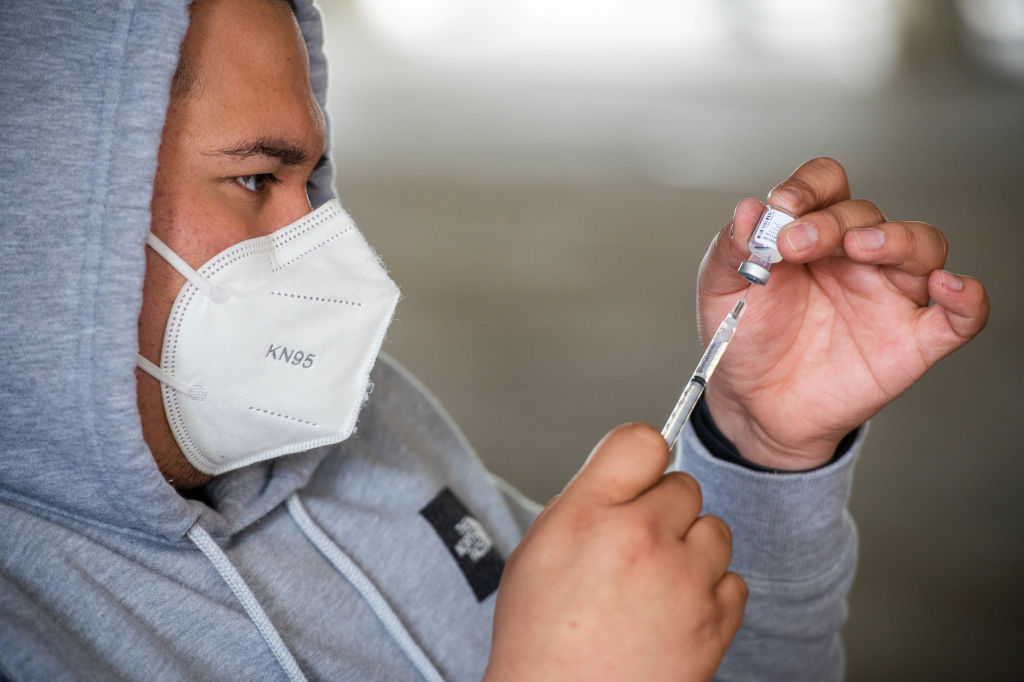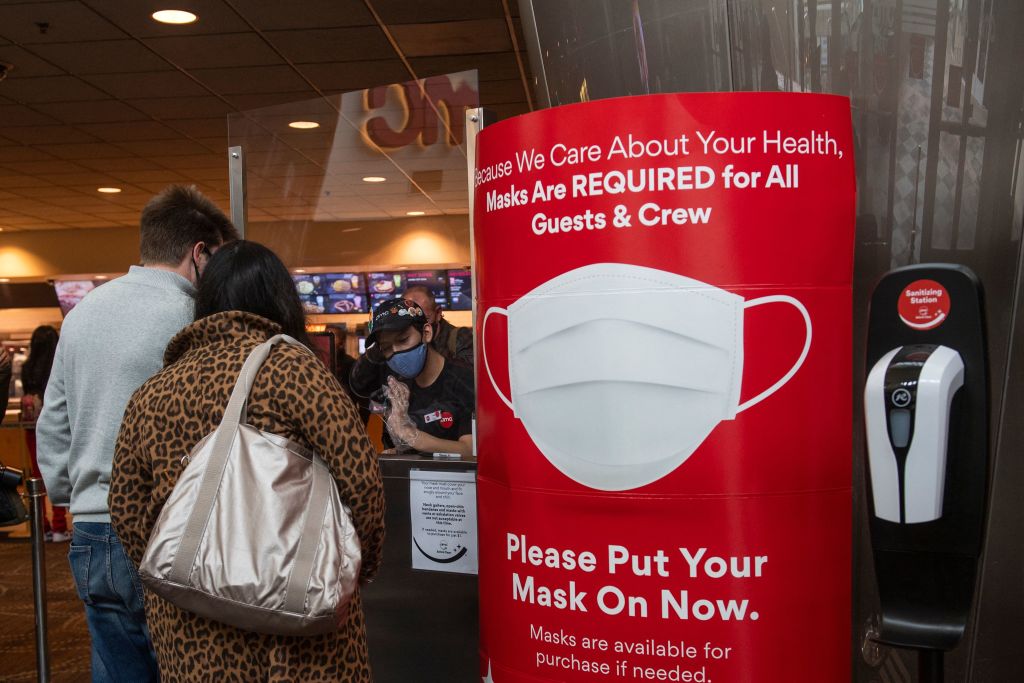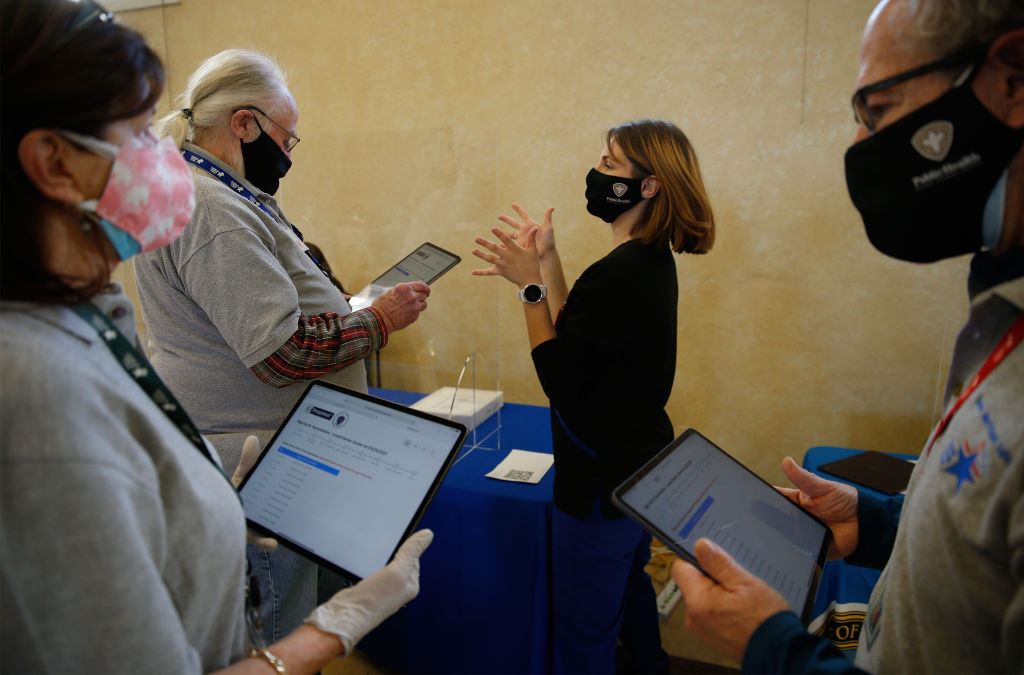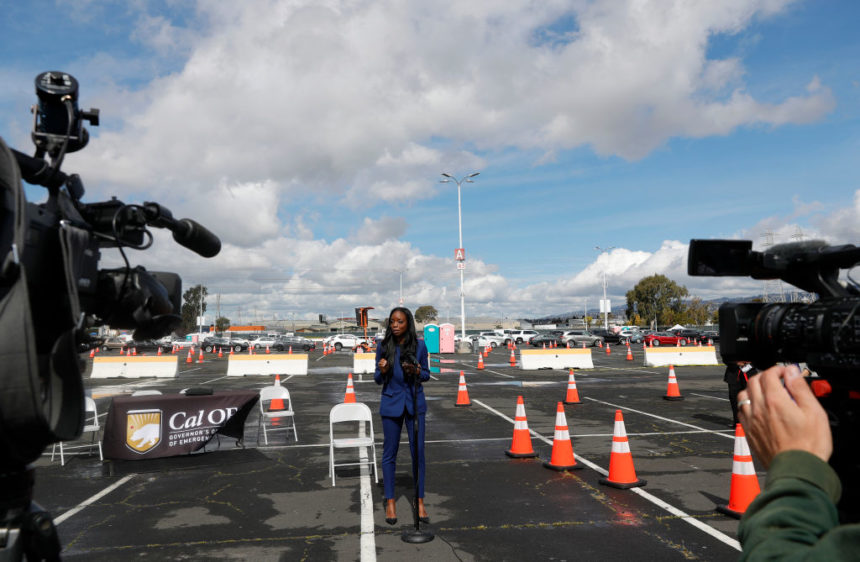“Meeting people where they are” is a term you hear a lot these days, and in the context of COVID-19 it has more than one meaning.
Physically, it means literally taking vaccine to the people, whether at immunization megasites in communities hard hit by the virus, pop-up and mobile vaccine clinics in traditionally underserved neighborhoods, local pharmacies, or even door-to-door delivery of shots to the homebound. Collectively, we’ve done that now to the tune of more than 110 million vaccine doses in the U.S.
From a communications standpoint, “meeting people where they are” means connecting with individuals, most notably the vaccine-hesitant, in the mental and emotional space they occupy. It means understanding and respecting the fact that they have questions and concerns, as opposed to challenging or belittling their beliefs. It means showing a willingness to listen and a readiness to provide unbiased answers from sources they can trust. It means opening the door to a vaccine conversation with a sincere show of empathy.
Both types of “meeting people where they are” are worthwhile journeys, traveling physically across the miles or psychically into human hearts and minds. Both types are now hard at work in grassroots efforts that don’t always make headlines.
Together they can help us get to the destination we long to reach. Think of it as not just many hands on the deck of the good ship Herd Immunity, but also many rowers—in government, healthcare, religion, education, the business community and the nonprofit world, as well as friends, family and neighbors—taking the oars of a lifeboat and guiding us safely to shore.
This week’s edition of The Vaccine Project newsletter is 3,461 words long and will take you 11 minutes to read.
The communication effort
The federal government is readying its own educational campaign to turn vaccine hesitancy into vaccine confidence. The Centers for Disease Control and Prevention laid some groundwork recently by posting a Rapid Community Assessment Guide on its website. The goal is to identify local communities at risk for low uptake of COVID-19 vaccine and develop interventions, tapping into the influence of community leaders and trusted messengers.
- Early in the year, PRWeek’s Steve Barrett declared that “business must step up and play a leading role in mending our country, bringing its organizational and entrepreneurial skills to the table. Effective communication will be crucial in achieving this. We simply must make America healthy again.”
- From Barrett’s lips to Biden’s ears. In late February, the White House announced a pandemic response partnership with leading business organizations, including the U.S. Chamber of Commerce, Business Roundtable, National Association of Manufacturers and minority business organizations from the Black, Hispanic and Asian communities. The ask, and the task, for business is to help reduce barriers to vaccination for employees and to amplify public health messaging around masking and vaccination.
- The Business Roundtable has its own initiative, Move the Needle, to “support the rollout of COVID-19 vaccines, increase vaccine uptake and encourage individuals to continue to wear masks and take other precautions.” Its website lists actions taken by individual companies, from donating masks to supporting local vaccination sites and offering employees incentives to be vaccinated. The Roundtable campaign “appears to take corporate activism to a new and more intense level,” crisis management authority Edward Segal writes in Forbes.
- Weber Shandwick has just unveiled its version of corporate COVID activism, noting that the months ahead will present “profound and crucial communications challenges for business leaders” and that “business has an imperative to step up and actively support, encourage and promote vaccination.” The agency’s Plan Vx is a customized management consulting package to help organizations fill that leadership role. In addition to private consulting, Weber Shandwick has put together a playbook, downloadable to all, that describes best practices for developing a communications plan, understanding vaccine hesitancy, engaging employees and getting involved in community efforts, with specific examples of how companies and brands are getting it done.
- Meanwhile, the CDC has guidance for employers who want to offer COVID-19 vaccination at the workplace.
- The nation’s largest private employer, Walmart, is hosting community vaccination events at 43 locations across 18 states. In addition to Walmart stores and parking lots, events are taking place offsite in partnership with community organizations, including a nonprofit serving immigrants in Las Vegas, the Indianapolis Urban League and the housing authority in Jackson, Mississippi.
- Beyond the logistics of getting folks vaccinated, Walmart has ramped up internal education to boost vaccine confidence. Lisa Smith, senior director of health and wellness, notes that pharmacy staff “already have extensive clinical training, but we’ve put a large focus on vaccine hesitancy training and educating our associates about the vaccine. We want to make sure everyone has the most accurate and up-to-date information to make the best health decisions for themselves and their families.” That thinking mirrors the core messaging—It’s Up to You—of the Ad Council/COVID Collaborative educational campaign.
- The key that unlocks the door to vaccine confidence is simply good listening, Kimberly Bonvissuto reports in McKnight’s Senior Living. In a conference call among long-term care leaders, George Mensah, a top adviser for the National Institutes of Health, explains what it means to meet people where they are: “If supervisors and organizations are going to be able to help staff overcome hesitancy and distrust, it must begin with listening, and creating and providing a safe and trusting environment that enables candid conversations, showing empathy and caring, and being honest and open.” Dr. Mensah is a member of the Community Engagement Alliance (CEAL) Against COVID-19 Disparities, which NIH set up last July to spark community engagement and outreach to communities disproportionately affected by COVID-19.
- Bonvissuto also shares the recommendations of an expert panel of behavioral scientists on how to increase vaccine uptake. The panel focuses on moving the “movable middle” from maybe to yes, noting that vaccine hesitancy is an attitude and not a behavior and that organizational culture and supervisor-employee relationships can have a profound influence. The recommendations include enlisting influential peers to build trust in vaccine safety and offering incentives for vaccination. For vaccine detractors, the advice is to minimize and defuse negativism by debunking misinformation while acknowledging individual freedom of choice.
- The consulting firm Mathematica, in assessing the COVID communications landscape, says that “science-based information is not enough” to gain vaccine acceptance among the wary. “Strategies must garner and amplify the voices of trusted, diverse community members to develop messages that resonate.” It’s important to identify key factors within each community’s decision making process that promote or inhibit acceptance of vaccination.
The Takeaway: What Mathematica said adds up.

The rollout
President Biden has called on all states to make all adults eligible for COVID-19 vaccination by May 1, a.k.a. Uno de Mayo, so that backyard barbecues can be a setting for long-lost togetherness on the Cuatro de Julio, a.k.a. the Fourth of July. Making that possible is a matter of pulling off a hat trick that includes increasing the supply of vaccine, vaccinators and vaccination sites.
- The Department of Health and Human Services has expanded the roster of eligible vaccinators to include dentists, EMTs, midwives, optometrists, paramedics, physician assistants, podiatrists, respiratory therapists and veterinarians, as well as medical students, nursing students and other students in healthcare professions. Those interested in signing up can do so here.
- Average Medicare payments for administering COVID-19 vaccines have risen from $28 to $40 for single-dose vaccines and from $45 to $80 for two-dose vaccines, effective March 15. The increase in payment is intended to help vaccination sites give more shots every day by hiring more staff, conducting patient outreach and education, and expanding physical facilities.
- Showing the way. Native American tribes, at high risk for hospitalization and death from COVID-19, are demonstrating what it takes to build community consensus on vaccination, Axios reports. Tribes are sovereign states that can set their own eligibility criteria, and they are outperforming 45 of the 50 states when it comes to immunization. The effort has succeeded primarily through tribal outreach, word of mouth and the determination of local leaders to invoke Indigenous principles: Recognizing how today’s actions will affect the next seven generations, honoring ancestors who fought for survival and elders who sustain cherished traditions and holding on to ancestral knowledge in an ongoing fight to protect Mother Earth.
- Abigail Echo-Hawk, director of the Seattle Urban Indian Health Institute and a citizen of the Pawnee Nation, told the Associated Press, “We already innately have held on to that cultural tradition of taking care of our community. The rest of the United States could learn from us.”
- You gotta have faith: An event held Tuesday night at the National Cathedral in Washington, D.C., was not a religious experience per se but rather an expression of faith in the safety and efficacy of COVID-19 vaccines. Leaders of more than two dozen faith communities received their shots on camera at a ceremony attended by chief White House medical adviser Anthony Fauci and National Institutes of Health Director Francis Collins.
- Leaders in services for the aging are urging the national COVID-19 response team to keep vulnerable seniors top of mind in allocating vaccine supply as the national push spreads to cover the rest of the adult population, Danielle Brown reports in McKnight’s Long-Term Care News. The situation in long-term care is dynamic: new residents and staff are coming in, while previously reluctant employees are warming up to the idea of getting their shots. The industry leaders also call for prioritizing older adults who are homebound or might struggle to get to a mass vaccination site because of physical or cognitive impairment.
- The race against COVID is not a sprint, it’s a… This time of year would normally be the run-up to the Boston Marathon, but the race is postponed until the fall. Not to worry: legendary road race organizer Dave McGillivray has found his niche by helping to run mass vaccination sites at Fenway Park, Gillette Stadium and other sports venues, collectively vaccinating up to 8,000 people a day. He’s finding lots of parallels, he told the Wall Street Journal, including the celebratory atmosphere. Nothing like taking your selfie in front of the Green Monster. The Fenway site is moving to Hynes Convention Center March 27 to allow something called “the baseball season” to get under way.
- Coolest little-known factoid of the week: Montana-based Acela Truck Co. has expanded its line of products for emergency and disaster response to include “purpose-built mobile vaccination and testing trailers.” The company is proud to play a crucial role in the nation’s response to COVID-19, particularly with regard to (shudder) “mobile mass fatality solutions.” The vaccination trailers are available to federal, state and local governments as well as hospitals and pharmacies.
The Takeaway: If we can just keep a good thing going and build on the vaccination momentum of the past few weeks, April can be the coolest, rather than the cruelest, month.

The challenges
Amid a rising tide of optimism and a wave of reopenings across the country, public health experts are warning that the recent decline in cases, hospitalizations and deaths could surge again unless we keep our vaccination rates up and don’t let our guard down on masking, distancing and avoiding crowds.
- There’s also a concern that instead of demand exceeding supply we’ll soon have plentiful doses awaiting an urgent call to arms. “We can’t just grab the low-hanging fruit now, of vaccinating the willing, and put off dealing with hesitancy until later,” Claire Hannan, executive director of the Association of Immunization managers, told The New York Times. “Later it will only be more difficult. We have to start building trust and trying to get vaccines out to communities where demand is low, especially if they are high risk.”
- Hitting the wall. Despite the surge in vaccinations, a core of resistance remains. That includes 49% of Republican men (versus 6% of Democratic men) who say they won’t get the vaccine when it’s available to them. The data come from the NPR/PBS News Hour/Marist survey, which reports that the hesitant include 25% of Black, 28% of white and 37% of Latino respondents.
- White House chief medical adviser Anthony Fauci said “it would make all the difference in the world” if former President Trump would encourage his supporters to get vaccinated. “This is not a political issue. It’s a public health issue.” The former President responded in a television interview Tuesday, advising his followers to get their shots. .
- A focus group of Trump voters, however, suggests that non-politicians would be more persuasive in gaining their ears and arms. “We want to be educated, not indoctrinated,” one said. The group was attentive to and appreciative of the science, but felt that the matter of vaccination had been weaponized and politicized. They also had no interest in being described as anti-vaxxers.
- The vaccine-hesitant include patients with blood cancers, according to a survey by the Leukemia and Lymphoma Society. About one in six (17%) of adults said they are not likely to be vaccinated, the most common reasons being concern about side effects and lack of sufficient testing. Cancer patients were not included in clinical trials, so it’s not known how effective the vaccines will be in cancer patients and whether their immune response to vaccine will be lower than in the general public. Nonetheless, COVID-19 vaccine is recommended for cancer patients by cancer advocacy organizations.
- Misconceptions abound. One third of seniors in a national survey mistakenly think they have to pay for vaccine, Diane Eastabrook reports in McKnight’s Home Care Daily. The good news from that survey, conducted in February: Only 5% of seniors said they don’t plan to be vaccinated, down from 15% last November.
- Severe allergic reactions to COVID-19 vaccines are low to date. In Infectious Disease Advisor, Chen Fang shares the data and summarizes precautions and contraindications.
The Takeaway: Lest we forget, the key concerns continue to focus on safety and side effects, the speed of vaccine development, trust (or lack thereof) in the political and economic motives behind the vaccination push and the proliferation of conspiracy theories. We’re still working on getting that basic message—vaccines work and save lives—to sink in.

The vaccine dashboard
Impressive results continue to roll in for COVID-19 vaccines and vaccine candidates, along with one notable snag.
- In a Phase 3 trial in the U.K., the Novavax vaccine candidate showed “final efficacy” of 96.4% against mild, moderate and severe disease caused by the original strain of SARS-Cov-2 and 100% protection against hospitalization and death. The vaccine also prevented severe outcomes caused by variants in the U.K. trial and another in South Africa.
- Two weeks after winning emergency use authorization in the U.S., the Johnson & Johnson COVID-19 vaccine pulled off a trifecta: an emergency use listing from the World Health Organization; a conditional marketing authorization covering all 27 nations in the European Union plus Norway, Iceland and Liechtenstein; and an interim order authorization from Health Canada. File this under things I learned today: More than 20 countries in Europe do not belong to the E.U., although a handful are on track to join. They are in effect pledging the E.U. sorority.
- Moderna has announced a trifecta of its own. It has begun a study of its COVID-19 vaccine in children 6 months up to 12 years of age. The Phase 2/3 study, called KidCOVE, will enroll up to 6,750 children in the U.S. and Canada. Moderna is also studying two booster vaccine candidates in people who previously received the original vaccine. Yet another Moderna study is evaluating the safety and immunogenicity of the company’s next generation COVID-19 vaccine, which could be given as a booster or as a primary vaccine.
- Pfizer is sharing—actually, widely disseminating—“real-world evidence” from the Ministry of Health in Israel, showing a dramatic reduction in COVID-19 disease among people who have received both doses of the Pfizer/BioNTech vaccine. Unvaccinated individuals were 44 times more likely to develop symptomatic COVID-19 and 29 times more likely to die of the disease. The data also suggest that the vaccine may prevent asymptomatic infection with SARS-CoV-2.
- A study within the Mayo Clinic network provides similarly encouraging news: an 80% reduction in the risk of asymptomatic infection in patients receiving two doses of either the Pfizer or Moderna vaccine. The report appears in Clinical Infectious Diseases.
- Several European countries are pausing the use of the AstraZeneca vaccine following reports of post-vaccination blood clots. The safety committee of the European Medicines Agency says the vaccine’s benefits “continue to outweigh its risks and the vaccine can continue to be administered while investigation of cases of thromboembolic events is ongoing.” Results of that investigation will be announced imminently. AstraZeneca says that more than 17 million doses have been administered in the E.U. and U.K. without evidence of an increased risk of pulmonary embolism, deep vein thrombosis or thrombocytopenia. The company expects to file for emergency use authorization in the U.S. within the next few weeks.
- But wait, there’s more. Clover Biopharmaceuticals recently completed a Phase 1 safety study of two COVID-19 vaccine candidates. Jessica Nye has details in Infectious Disease Advisor. Clover is based not in Ireland but in China, and the trial was conducted in Australia. Next steps: A global phase 2/3 trial in the first half of this year with an interim analysis for vaccine efficacy possibly by mid-year.
- You’ve heard of the G7 powers, now meet the Quad, short for Quadrilateral Security Dialogue, a group that includes the heads of state in the U.S., India, Australia and Japan. The Quad has agreed to deliver up to a billion doses of vaccine to the Southeast Asian nations by the end of 2022. In true multilateral spirit, manufacturing will come from India, technology from the U.S., financing from the U.S. and Japan, and logistics support from the Aussies. The plan does not involve sharing U.S. vaccines with the rest of the world just yet, but the dialogue on “vaccine nationalism” is gaining traction.
The Takeaway: It’s helpful to remember that the most important punch in boxing is the jab. The best defense is a good offense.
The long view
Much has been lost, but much has been gained in this pandemic. We are beginning to understand the imprint the pandemic has left on our world, for good as well as ill. In MM+M, Sara Holoubek describes four innovations that have found their “use case.” (1) The power of public health data, dramatically demonstrated by the Covid Tracking Project, Covid Act Now and the federal government’s COVID-19 Community Profile Report; (2) The ability to translate data into action quickly, as in triaging the treatment of COVID patients and determining priority for vaccination; (3) The “a-ha!” moment for telehealth and its offshoots, including the use of remote technology in simplifying and speeding clinical trials; and (4) The advent of mRNA technology in vaccine development, “the penicillin of our era.”
Holoubek mentions the work of Hungarian biochemist Katalin Karikó, whose early research on mRNA was resoundingly rejected. If she doesn’t win a Nobel for Science and Physiology, she should receive one for Belief and Perseverance. As it happens, Joseph Heller’s epic novel, Catch-22, was rejected by publishers—are you ready for this—22 times.
Finding empathy. The pandemic is forcing marketers to pivot from brand health to public health, Carat USA chief strategy officer Haley Paas writes in Campaign. It’s important, for example, to understand and appreciate the many different reasons why people may be reluctant to get vaccinated. “As strategists, innovators and marketers, it is our job to put ourselves in other people’s shoes,” Paas says. “Empathy is what differentiates the best of our craft from the mediocre.”
The next pandemic, and the one after that. If you thought Operation Warp Speed was fast, the Coalition for Epidemic Preparedness Innovations wants to prepare for future pandemics by cutting the timeline for vaccine development to 100 days. CEPI, formed in 2017 and headquartered in Oslo, is a global partner in accelerating vaccine development for emerging infectious diseases and ensuring equitable access when outbreaks occur.
… and some songs from Grammy winners
Crowded Table, The Highwomen (Best Country Song)
I Can’t Breathe, H.E.R. (Song of the Year)
Rain on Me, Lady Gaga and Ariana Grande (Best Pop/Duo)
Anything for You, Ledisi (Best Traditional R&B)
I Remember Everything, John Prine (Best American Roots Performance)
(see the full list of Grammy winners here)
Keep singing and we’ll see you here tomorrow with a Haymarket Coronavirus Briefing that reflects on life and living in these pandemic times. Stay well, all.







